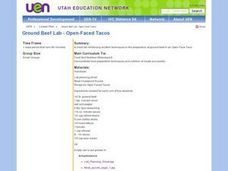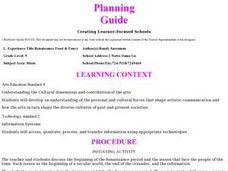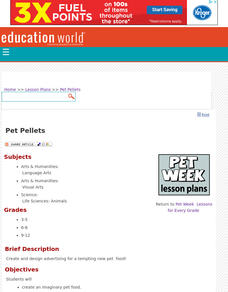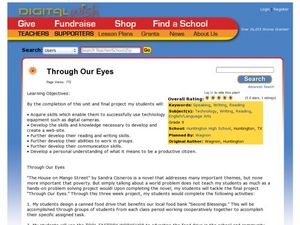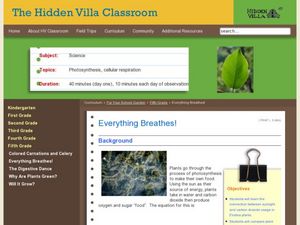Curated OER
Youth Obesity: Schools Fight Back
Kids fight obesity by comparing the USDA food intake suggestions to what they personally consume throughout the day. They watch a video, read texts, and explore related vocabulary which they use as they compose an oral presentation.
Curated OER
Open-Faced Tacos
Students practice safe handling procedures in a lab experience by handling ground beef properly in the preparation of a recipe. They prepare and assemble Open Faced Tacos. Afterward, they eat their prepared meal and complete several...
Curated OER
Oil Spill Lesson Plans
With the recent oil spill in the Gulf of Mexico, now is a great time to educate students on issues related to oil.
Curated OER
Is It Hog Wash, or Not?
Students investigate pathogens that can be present in pork products and summarize the responsibilities of pork farmers in ensuring the safety of their products. They also investigate the affects of hog farming on the environment and...
Curated OER
Renaissance Feast & Fancy
Ninth graders investigate the recreation, music, clothing, and food of the Renaissance period. In small groups, they research a topic, and plan activities, music, food, and costumes to be used in a Renaissance Feast.
Teach Engineering
The Great Pacific Garbage Patch
The Great Pacific Garbage Patch is one of several garbage patches around the world where garbage accumulates naturally. As part of a GIS unit that combines oceanography, environmental science, and life science, class members investigate...
Curated OER
Check Out This Label
Students participate in a discussion on why food labels are important and how they were developed. Using the internet, they research what is meant by the 'use by' date and discover how the ingredients are listed on the package. They use...
Curated OER
Restaurants and Institutional Examination 4
Match the vocabulary terms in column A with the definitions in column B. Write the letter of the definition in column B in the space next to the terms in column A.Write short answers or fill in the blank to the following questions and...
Curated OER
"Leaf" It in Your Yard
Students research about the process of composting. Students apply their research by creating a compost pile at school that will be maintained once or twice a month for the remainder of the school year.
Curated OER
Culinary Culture Quiz
The French bake some of the most delectable treats in the world. After you've discussed the French food culture and French recipes with your class, give them this quiz to assess their understanding. After they read the cooking directions...
Curated OER
World Hunger - A Cultural Crisis
Students explore the problem of world hunger and starvation. After a class discussion, students use a map to identify specific areas where populations are starving. In groups, students research reasons for the lack of food. They prepare...
Curated OER
Recycling-Taking it Easy on the Environment
Students review the garbage/landfill graphs included with the instructional activity. They discuss the information on the graphs and discuss which garbage products come from their homes. Students collect examples of over packaging to...
Curated OER
A Day on a Farm
Students discuss their morning as they prepared to come to school. The teacher guides the discussion so students understand ways they relied on agriculture to accomplish tasks. Students view pictures of various farm machinery. As the...
Curated OER
Calorie Countdown
Students identify the advantages of a healthy diet and exercise plan. In this health activity, students bring in labels of different food products and calculate the amount of calories each serving is. Students keep a food diary to keep...
Curated OER
The History of Maple Syrup
Students explore the process of harvesting maple syrup. In this science and history lesson, students make their own maple syrup and create a picture book that shows the Native American and American pioneer methods of making the syrup.
Curated OER
Little Red Hen
First graders explore biology by identifying plant anatomy in class. In this botany lesson, 1st graders read the book The Little Red Hen and identify the methods used in order to grow successful plants. Students discuss other ways people...
Curated OER
Reading Food Labels
Students investigate the concept of phonemic awareness in order to help increase reading comprehension. The reading of food labels creates the context for the practice session. They pay particular attention to certain sounds that must be...
Curated OER
Pet Pellets
Students create and design advertising for a tempting new pet food! They create an imaginary pet food, analyze and identify types of propaganda and design packaging and advertising for the pet food.
Curated OER
Through Our Eyes
After reading Sandra Cisneros’ novel The House on Mango Street, class members design a canned food drive, create advertisements for the drive, and use digital cameras to document the entire process. In addition, pupils journal their...
Curated OER
Everything Breathes!
Fifth graders test plants in the dark and in the light to see which grows better and produces more carbon dioxide. In this plants lesson plan, 5th graders also create ways for plants to go through photosynthesis that they can observe.
Curated OER
Kernel Count!
Here is an impressive and thorough lesson on estimation. Young mathematicians estimate how many kernels of popcorn can fit in a tablespoon, then how many tablespoons of kernels can fit in a baby food jar. The popcorn is then popped. All...
Curated OER
Homer Price
An engaging and unique lesson that combines literature and economics is here for you. In it, learners read the short story, "The Doghnuts" found in the book Homer Price. Pupils define "capital resources," and utilize a worksheet...
Curated OER
Make a Farm
After a class discussion about where their food comes from learners construct a farm from a print-out (embedded in the plan). They work in groups, and trace a food source from the beginning. For example, they discover how a farmer grows...
Girl Scouts
Daisy Making Choices Leaf
Shed light on the concept of financial literacy with a series of four activities that examines needs vs. wants, gives scholars the opportunity to buy products using paper money, and set goals to save money.



